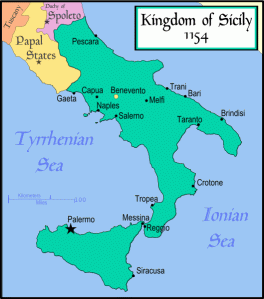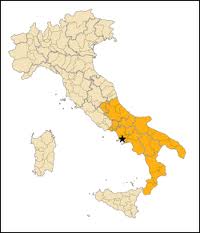The Italian Angevins were a sovereign dynasty of the Kingdom of Sicily / Naples, founded by Charles I, brother of the French King, Louis IX, and Count of Anjou, Maine and Provence, in 1266. Notable rulers of this dynasty include Charles I’s son, Charles II (reigned 1285-1309), grandson Robert (the Wise) (reigned 1309-1343), and great-great granddaughter Joanna I (reigned 1343-1382).
From its Neapolitan court, the dynasty became embroiled in political rivalries near and far: its alliance with the Papacy made it the enemy of the Italian Ghibelline factions, and disputes over territory and trading rights led to antagonisms with the sovereign powers of Aragon, Byzantium and North Africa.
Although the Angevins exerted much influence throughout the Italian peninsular, their sovereign territory is known as the Regno, which for the period 1266-1282 refers to the Kingdom of Sicily, an area previously under the control of the Noman and Hohenstaufen dynasties, encompassing both the southern Italian mainland and insular Sicily. Following the popular uprising against Angevin rule and subsequent war involving the Kingdom of Aragon (known as The Sicilian Vespers), Charles I lost control of the island of Sicily in 1282, from which point the Angevin Regno refers to the Kingdom of Naples only.
From the earliest days of his occupation of the Regno, Charles I concentrated on expanding his territories overseas, claiming rights over the Kingdom of Albania (1272), the Kingdom of Jerusalem (1277), and the Principality of Achaea (1278). Marriage alliances were another important aspect of the Angevins’ international ambitions, as shown by Charles II’s marriage to Maria of Hungary (1270), Charles Martel’s marriage to Clemence of Austria (1281), and Robert the Wise’s marriages to Yolanda of Aragon (1297) and Sancia of Majorca (1304). Despite the increasingly international reach of the Italian Angevins, they continued to identify themselves with their French ancestry, adopting the Capetian fleur de lys as their heraldic symbol, as shown in the images of King Robert included in this website. In fact, while we refer to Charles I’s dynasty as “Angevin”, it was commonly identified as Capetian during the Middle Ages, thus drawing it within the orbit of a supranational, and distinctly francophone, ruling elite.
Angevin rule of the Regno came to an end in 1442, when the kingdom was conquered by the King of Aragon, whose rule temporarily reunited the southern Italian mainland with insular Sicily. The Angevins left behind an enormous documentary archive of hundreds of volumes of textual witnesses to their cultural and administrative practices, thought to be one of the most valuable collections of primary source material for the European Middle Ages. The obliteration of this archive during the Second World War represents a tragic destruction of historical memory, only partly alleviated by its fragmentary reconstruction during the twentieth and early twenty-first centuries.[1]
The occasion of this conference, The Italian Angevins: Naples and Beyond, 1266-1422, reflects a growing appreciation of the influence of the Italian Angevins throughout the Middle Ages and the Renaissance, not only in local and international politics, but also in commercial, literary and artistic networks throughout Italy and abroad.
[1] This monumental reconstruction, in 49 volumes, was made possible by fragmentary transcriptions of the archive, made by scholars before its destruction. See Registri della cancelleria angioina, 49 vols., ed. Riccardo Filangieri et al., Napoli: Academia Pontaniana, 1951-2006.

